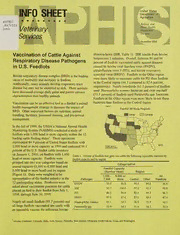
Vaccination of cattle against respiratory disease pathogens in U.S. feedlots PDF
Preview Vaccination of cattle against respiratory disease pathogens in U.S. feedlots
Historic, Archive Document Do not assume content reflects current scientific knowledge, policies, or practices. Vaccination of Cattle Against rhinotracheitis (IBR, Table 1). IBR results from bovine herpesvirus | infection. Overall, between 86 and 94 Respiratory Disease Pathogens percent of feedlots vaccinated cattle against diseases in U.S. Feedlots caused by bovine viral diarrhea virus (BVDV), parainfluenza virus 3 (PI3), and bovine respiratory syncytial virus (BRSV). Feedlots in the Other region Bovine respiratory disease complex (BRD) is the leading were more likely to vaccinate cattle for PI3 than feedlots cause of morbidity and mortality in feedlots. in the Central region (94.3 compared to 82.6 percent, Additionally, many animals develop respiratory tract respectively). Nearly two-thirds (62.1 percent) of feedlots disease but may not be identified as sick. These animals used Haemophilus somnus bacterins and over one-half have decreased average daily gains and poorer carcass (53.3 percent) of feedlots used Pasteurella spp. bacterins. characteristics than healthy animals. Feedlots in the Other region were more likely to use these bacterins than feedlots in the Central region. Vaccination can be an effective tool in a feedlot’s animal health management strategy to decrease the impact of Figure 1 Feedlot '99 Study Regions BRD. Other important factors are nutrition, animal handling, facilities, personnel training, and pre-arrival 8 Other Central management. In the fall of 1999, the USDA’s National Animal Health Monitoring System (NAHMS) conducted a study of feedlots with 1,000 head or more capacity within the 12 leading cattle feeding states’. These operations represented 84.9 percent of United States feedlots with 1,000 head or more capacity in 1999 and contained 96.1 Shaded states = Participating states. percent of the U.S. feedlot cattle inventory on January 1, 2000, on feedlots with 1,000 Table 1. Percent of feedlots that gave any cattle the following injectable vaccines by head or more capacity. Feedlots were feedlot capacity and by region. grouped into two size categories based on Categorization animal capacity (1,000 to 8,000 head and Feedlot Capacity 8,000 head or more head) and by region (Number Head) Region (Figure 1). Data were weighted to be 1,000- 8,000 or All representative of the feedlot industry in the Pathogen 7,999 More Central Other Feedlots 12 participating states. Producers were BVDV 93.5 96.8 94.5 94.2 94.4 asked about vaccination practices for cattle BR 95.7 100.0 97.4 95.7 96.9 placed on feed in their feedlot from July 1, a 1998, through June 30, 1999. : 86.2 86.6 82.6 94.3 86.3 BRSV 87.3 87.6 87.0 88.3 87.4 Nearly all small feedlots (95.7 percent) and Haemophilus somnus 65.1 54.1 56.9 12S 62.1 all large feedlots vaccinated any cattle with Pasteurella spp. 52.9 54.3 51.0 58.3 53.3 an injectable vaccine for infectious bovine 1 arizona, California, Colorado, Idaho, Iowa, Kansas, Nebraska, New Mexico, Oklahoma, South Dakota, Texas, and Washington Of all cattle placed on Table 2. Percent of cattle given the following injectable vaccines by feedlot capacity and by region. feed, 96.9 percent were Categorization vaccinated using an ap : i Feedlot Capacity (Number Head) Region injectable vaccine against All IBR (Table 2). More Pathogen 1,000-7,999 8,0000rGreater Central Other _—-Feedlots than 87 percent of cattle Woy a, placed were vaccinated BVDV 89.5 87.3 87.7 87.9 ; against BVDV. A IBR O5a1 SIL 97.1 96.0 96.9 greater percentage of PI3 79.8 23 70.0 96.9 T33 cattle placed in small BRSV 87.3 67.8 70.3 74.8 70.9 feedlots (87.3 percent) Haemophilus somnus 49.7 30.7 32.8 40.4 33.8 than in large feedlots PASeCrenin ope 34.9 26.1 25.2 42.8 2735 (67.8 percent) were Se RRS oy ra a reer sere one TPN eT eo Phe vaccinated against Figure 2 BRSV. Percent of Cattle Vaccinated Against Respiratory : Pathogens by Region Cattle placed in feedlots in the ' ‘ Other region were more likely to Region s be vaccinated against P13, Central — Other [ff All Feedlots Pasteurella spp., and H. somnus percent Cattle than cattle placed in the Central 459 region (Figure 2). Overall, approximately one-quarter and 75 one-third of cattle placed were injected with a H. somnus or Pasteurella spp. bacterin, 50 ‘respectively. ZS Over one-third (39.0 percent) of feedlots used an intranasal ees vaccine against IBR. A greater BVD PI3 Hemophilus somnus percentage of large feedlots IBR BRSV Pasteurella (43.6 percent) than small Respiratory Pathogen feedlots (37.2 percent) used #4372 these vaccines. Overall, 8.7 percent of cattle placed were vaccinated with an intranasal IBR vaccine. A smaller percentage of cattle placed in large feedlots (7.7 percent) than in small feedlots (14.1 For more information, contact: percent) were vaccinated using an intranasal IBR vaccine. Centers for Epidemiology and Animal Health Using either an injectable or intranasal preparation, all USDA:APHIS:VS, attn. NAHMS 555 South Howes cattle placed in large feedlots and 96.6 percent of cattle Fort Collins, CO 80521 placed in small feedlots were vaccinated against IBR. (970) 490-8000 F ‘ : ; : NAHMSweb@usda. gov Bovine respiratory disease is the leading cause of saplisaisdeiecivelces Wan morbidity and mortality in feedlot cattle. Vaccination can #N342.1100 be a valuable tool to aid in the control of BRD in cattle. n The Feedlot '99 study found that most cattle were / M vaccinated against at least some respiratory pathogens, either using injectable or intranasal vaccines. : f
